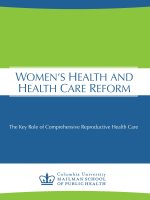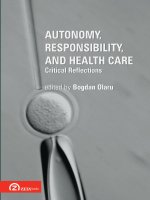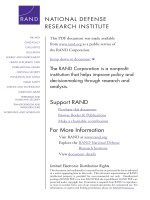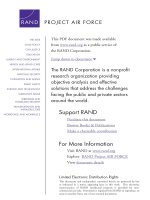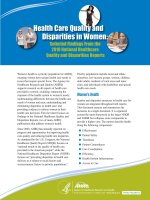Autonomy, Responsibility, and Health Care - Critical Reflections potx
Bạn đang xem bản rút gọn của tài liệu. Xem và tải ngay bản đầy đủ của tài liệu tại đây (2.88 MB, 244 trang )
AUTONOMY, RESPONSIBILITY,
AND HEALTH CARE
AUTONOMY, RESPONSIBILITY,
AND HEALTH CARE
Critical Reections
edited by Bogdan Olaru
¤
¤
www.zetabooks.com
Bucharest, 2008
Cover design : Paul Balogh
DTP : Paul Balogh
Copyright belongs to the authors.
First published in printed and electronic format 2008.
is book was funded by CNCSIS, under the research project “Biopolitics”
(193/2006-07). To read more about this project please visit the webpage:
or write to:
ISBN: 978-973-1997-16-2 (paperback)
ISBN: 978-973-1997-17-9 (eBook)
TABLE OF CONTENTS
NOTES ON CONTRIBUTORS . . . . . . . . . . . . . . . . . . . . . . vii
FOREWORD . . . . . . . . . . . . . . . . . . . . . . . . . . . . . . . . . . . . . . 1
1. AUTONOMY AND EMBODIMENT. THE WAY BACK
TO THE UNAVAILABILITY OF THE BODY
Autonomy: as Self-determination against, or as Self-transcendence
to Others? Anthropological Reections on the Background of Bioethics
Regine Kather, Freiburg University (Germany) . . . . . . . . . . 15
Why the Way we Consider the Body Matters:
Reections on four Bioethical Perspectives on the Human Body
Silke Schicktanz, University Medical Center
Göttingen (Germany) . . . . . . . . . . . . . . . . . . . . . . . . . . . . . 45
2. AUTONOMY AND CARE FROM THE PERSPECTIVE
OF ENDOFLIFE DECISIONMAKING
Autonomie als Selbstbestimmung und Fürsorge:
aufgezeigt am Beispiel der Sterbehilfe
Karl-Wilhelm Merks, Tilburg University (Netherlands) . . . . 79
Autonomie und Fürsorge. Die Perspektive des Rechts
Volker Lipp, Göttingen University (Germany) . . . . . . . . . . 95
3. PECULIAR FORMS OF RESPONSIBILITY?
e Limits of Discourse Ethics Concerning the Responsibility
toward Nature, Nonhuman Animals, and Future Generations
Nicolae Morar, Purdue University (USA) . . . . . . . . . . . . . 129
Toward an Ethics of Species. Is there a Responsibility
to Preserve the Integrity of (Human) Species?
Bogdan Olaru, Jassy Institute for Economic
and Social Research (Romania) . . . . . . . . . . . . . . . . . . . . . 159
e Principle of Responsibility for Illness and its Application
in the Allocation of Health Care: A Critical Analysis
Eugen Huzum, Jassy Institute for Economic
and Social Research (Romania) . . . . . . . . . . . . . . . . . . . . . 191
Index of Concepts . . . . . . . . . . . . . . . . . . . . . . . . . . . . . . . . . 221
Index of Names . . . . . . . . . . . . . . . . . . . . . . . . . . . . . . . . . . . 227
NOTES ON CONTRIBUTORS
E H lives in Jassy, Romania, where he studied philoso-
phy and political science. He now works as a researcher at the Jassy
Institute for Economic and Social Research. His interest elds include
foundationalism, metaethics, theory of social justice, and multicultur-
alism. His last research project dealt with the politics of recognition
and distributive justice.
R K is professor at the University of Freiburg (Germany).
She was associate professor at the University of Bucharest and visiting
professor at the University of Cluj-Napoca (Romania). Regine Kather’s
work is mainly in philosophy of nature and in philosophical anthro-
pology. She is author of Was ist ‘Leben’? Philosophische Positionen und
Perspektiven (Darmstadt, 2003) and Person. Die Begründung menschli-
cher Identität (Darmstadt, 2007).
V L is professor of civil law, law of civil procedure, and
comparative law at the University of Göttingen (Germany), and was,
inter alia, visiting fellow at the Institute of Advanced Legal Studies,
University of London. He has written on subjects in bioethics, with spe-
cic interests in the legal and policy issues. His more recent books are
Patientenautonomie und Lebensschutz. Zur Diskussion um eine gesetzli-
che Regelung der ‘Sterbehilfe’ (Göttingen, 2005) and Familienrechtlicher
Status und Solidarität (co-authored with Anne Röthel and Peter
A.Windel, Tübingen, 2008)
K-W M is member of the Scientic Advice Council
of the Centre for Intercultural Ethics at the University of Tilbug
(Netherlands). He is author of Verantwortung – Ende oder Wandlungen
einer Vorstellung?: Orte und Funktionen der Ethik in unserer Gesellschaft
(Münster, 2001), Gott und die Moral: eologische Ethik heute (Münster,
NOTES ON CONTRIBUTORS
viii
1998), and co-editor, with Frans Vosman, of Aiming at Happiness: e
Moral Teaching in the Catechism of the Catholic Church (Kampen,
1996).
N M is a PhD student at Purdue University, USA.
He received his Master degree in 2005 from Lyon III “Jean Moulin”
University with a thesis entitled “Les enjeux de la médicine reproduc-
tive aux Etats-Unis: entre Ethique et Politique.” He is interested in
Continental Philosophy, especially Foucault, Deleuze, Agamben, and
Sloterdijk and its connections with applied ethics (genetic testing/ bio-
power). He is also the founder and the co-organizer of the Bioethics
Seminar Lectures at Purdue University.
B O has studied philosophy at Alexandru Ioan Cuza
University of Jassy (Romania) and Humboldt University of Berlin. He
worked for nine years as a researcher at the Jassy Institute for Economic
and Social Research. His primary areas of interest currently include
bioethics, ethical theory, and phenomenology. He has edited Current
Ethical Controversies in Biotechnology: Individual Autonomy and Social
Responsibility (Jassy, 2008), and his most recent publications address
assisted reproductive technologies and stem-cell research.
S S is professor at the University of Göttingen
(Germany), where she teaches in the Department of Medical Ethics
and History of Medicine. Her research and teaching interests include
organ transplantation, xenotransplantation, and ethical and socio-cul-
tural aspects of human reproduction and sexuality. She took part in
the EU-Research Project “Challenges of Biomedicine—Socio-Cultural
Contexts, European Governance and Bioethics” which focused on
the socio-cultural background of modern biomedicine in dierent
European countries. She has published numerous articles and co-edited
several books on ethical and social issues in health care.
FOREWORD
is book brings before the readers’ eyes the work of a group of ded-
icated researchers whose interest lies in moral philosophy and applied
ethics. e contributors had the liberty to choose the application elds
and the examples that best illustrate their arguments. Nevertheless,
they all put the main stress on two issues which seems to be the key to
understand many of the today’s bioethical challenges: the autonomy
claim and the question of moral responsibility arising in various elds
of applied medical research.
e book addresses some classical questions such as: what is the
meaning of autonomy? What justies it? How come infringements
against the autonomy claim make sense sometimes? How do we rec-
ognize overriding moral demands? Still, these questions are far from
being fully answered here. e natural way to tackle these issues is to
put the claim of personal autonomy in some kind of balance with other
values, and to weigh the relative importance of dierent imperatives
which (seem to) conict with one another. us, we usually lose our
aim in philosophical quarrels, because we face conceptual patterns
which seem to be irreconcilable: autonomy and care, autonomy and
justice, autonomy and solidarity, autonomy and trust, etc. Last in this
series, for instance, constitutes the focus of a recent book by Onora
O’Neill,
1
in which she describes in quite a straightforward manner, the
conict between autonomy, as precondition for individual liberty, on
the one hand, and trust, as basis for social cooperation and solidarity,
on the other. e other way to think about this is to see the clashing
claims as moral demands which complement one another, and, if truth
be told, this is what we expect and how things really work. We do
justice only when and if, we really consider what people’s wishes look
1 Onora O’Neill, Autonomy and Trust in Bioethics (Cambridge
University Press, 2002).
BOGDAN OLARU
2
like, and we show respect for their wishes especially when we take care
of them. Or, to put it another way, to care about someone generally
means to respect his or her wish to make decisions for him or herself.
As a matter of fact, most of us expect the others to practice precisely
this form of care, especially in matters such as reproductive issues or
end-of-life decisions.
But this is not the end of the story. In most cases, we manage
to recognize the individual responsibility that goes together with the
exercise of free choice and autonomous action. Yet, there are times
when we fail to do so. Let us consider this well-known example: We
have an obligation not to make use of our environment as we please,
that is, for instance, not to use the natural resources irrespective of
what would benet or harm the next generations. But it is dicult to
point to a particular entity in charge of this form of ecological respon-
sibility. Individuals as well as institutions, life-style as well as cultural
habits, have a part to play in shaping this special form of responsibil-
ity. Let’s take another example: active family planning and responsible
parenthood. We usually think of the decision to have a child as the
very expression of free choice and prize this as the genuine illustra-
tion of the autonomy claim. We should think so irrespective of how
old the parents are, and we would never allow anyone to set the right
time for parenthood on our behalf. en why should we dismiss as
weird or even ‘abnormal’ the wish to have a child when it comes from
a sixty-year-old woman or even older? What makes such a decision
look so peculiar? Is it not because we only point to her age over and
over? But does her wish to have a child dier substantially from the
same wish of other women, apart from the fact that the latter would
eventually want the same at earlier ages? It seems that there are deeply
rooted boundaries about these things and that most people nd no dif-
culty in addressing them when it comes to actions which don’t t into
traditional patterns. Perhaps these boundaries are not only cultural,
but also anthropologically given, and therefore, we must include the
anthropological dimension in a more comprehensive understanding of
FOREWORD
3
the autonomy concept. Only then, the charge of border-crossing could
eventually make sense (if ever)—not because of some kind of incom-
patibility between one’s age and what he or she wants to achieve in
some circumstances, but because of the gap between the self-assumed
decisions and the responsibility which follows from them.
One of the most dicult questions is, then, how to link human
responsibility to those consequences of action which no one can fully
foresee but, nevertheless, which no one can aord to neglect. Many
biotechnological challenges are of the same nature. We just cannot
foresee the complete range of virtual social and moral costs of genetic
screening for reproductive purposes or of human germline engineering
and gene therapy for humans or animals. is is why we must explore
special obligations grasped under peculiar formulae like ‘genetic
responsibility’
2
or ‘responsibility for the species integrity.’
3
In arguing
about such new obligations, the big unknown variable is whether we
really identify and describe genuine responsibilities or only inate the
eld upon which we just want to extend our control. We see ourselves
nowadays confronted with strong and even more unusual autonomy
claims (the wish of a Finnish lesbian couple to have a child could
be another such example), while the solution to conicting demands
becomes increasingly fuzzy and parochial. I believe we face here a cir-
cular, but non-vicious, legitimating process that any autonomy claim
inevitably goes through: If autonomy makes up the necessary condi-
tion to take responsibility and if the latter functions as a factual limit
for the former, we stand before a process of mutual justication and,
possibly, of mutual limitation. I hope that this book will bring some
insights into this process.
2 omas Lemke, Veranlagung und Verantwortung. Genetische
Diagnostik zwischen Selbstbestimmung und Schicksal (Bielefeld: Transcript,
2004).
3 Jürgen Habermas, Die Zukunft der menschlichen Natur. Auf dem Weg
zu einer liberalen Eugenik? (Frankfurt/M.: Suhrkamp, 2001).
BOGDAN OLARU
4
e rst paper deals with some well-known and very popu-
lar assumptions about personal autonomy and human identity. e
main line of the traditional approach identies autonomy with the
ability to recognize and pursue one’s interests and preferences. To act
autonomously means to act fully independent of external factors and
exclusively dependent of internal inuences. Regine Kather shows
that this understanding of autonomy owes its popularity to the classi-
cal segregation between mind and body. Human essence and the very
core of personal identity must lie in one’s mind, not in one’s body—
this is what philosophy rmly teaches us, from Plato to Hume, and
to (some trends of) the present-day bioethics. Regine Kather argues
against the precarious reduction of personal identity to interests and
to the mere ability to express them. If we embrace this reductionist
approach, the rst thing that we lose from sight is the signicance of
the human body to one’s own biography. But the reduction would also
lead to unacceptable treatments of borderline cases like haemophiliac
newborns, dying patients, and people suering from dementia, or lying
in a state of irreversible coma. If we study the development of human
identity from the physical and psychological point of view, we must
acknowledge the signicance of at least two aspects which contribute to
a more comprehensive concept of personal identity: the relations with
others and the reference to one’s own body. e analysis underlines
the various ways in which the body represents a medium of express-
ing intentions and meanings. e body is not only the genetic and
physiological basis of personal identity, but it also contributes to the
very biography of its owner through interpersonal mediation. If this
is true, it is not the mind, but the living body, which “guarantees the
singularity of a person even if it is not self-conscious.” (p. 40) From this
argument follows the priority of the living body as a medium of com-
munication over the individual interests when it comes about dening
personal identity. is ‘shift in the anthropological premises’ is based
upon the concept of ‘bodily autonomy’, by which Wim Dekkers means
the “combination of the biomedical notion of bodily automatisms and
FOREWORD
5
the phenomenological idea of the lived body.” (p. 39) If the living
body is a part of the biography, and if it participates in expressing at
least some basic intentions, the argument turns into a plea for setting
a higher valuation on the human body especially in those situations
when the personal life is not yet fully developed or when it is irrevers-
ibly destroyed.
e next study deals also with the relationship between body and
autonomy, and its signicance for medical ethics. Silke Schicktanz
argues that we must become aware of the anthropological and epis-
temic premises about the human body. She raises some objections to
the way the traditional ethical theories have explained main ethical
concepts without any relation to the body. Many of these concepts,
like self-determination, personhood, preferences, or rationality must
be considered as interwoven with anthropological facts. e anthro-
pological and epistemic presuppositions about body and embodiment
determine, for instance, the way we see ourselves as autonomous
subjects. Autonomy is widely understood as the ‘unavailability’ of
the body. A typical partisan of liberal self-determination would act
according to the maxim: “My body belongs to me!” e insight that
any living body is a suering body, an entity that can be harmed and
give rise to both pleasant and unpleasant feelings, provide the back-
ground for the bioethical principle of nonmalecence. Other examples
can easily follow this argumentation. is study focuses, however,
on four normative perspectives on the relationship between embodi-
ment and autonomy. e four concepts, which are rather alternative
or even antagonistic, are viewed as complementary to one another,
so no one could claim any sort of primacy. Four body-autonomy
relationships are discussed: 1) Autonomy as the right to bodily self-
determination; 2) Moral or relational autonomy, which includes the
respect for another person’s bodily integrity; 3) Autonomy as self-crit-
ical reection, which focuses on the individual conception about what
a good life means and includes a form of care for one’s own body; 4)
Autonomy expressed by means of specic forms of bodily interaction
BOGDAN OLARU
6
and of bodily-constituted communities. e latter is vital, when the
body and bodily expressions are constitutive for specic social inter-
actions (like parenthood, partnerships or friendship), and when the
person’s social identity develops by sharing bodily experience. e
narrow relationship between embodiment and autonomy is illustrated
further by applying the four perspectives to controversial issues like
transplantation medicine, neuroprosthesis and cosmetic surgery. ese
are examples of ‘transgressing body borders’ with deep consequences
over the bodily integrity. ey bring into the limelight another three
important elds in medical ethics, besides reproductive medicine and
women’s health, for which the way we consider and understand the
body seems to be quite critical. It turns out that the body is not just
a second level of reection, but quite a decisive issue in dealing with
bioethical questions.
Karl-Wilhelm Merks has also approached the moral sense of per-
sonal autonomy in medical ethics. For many theoreticians of modern
biomedical ethics, the autonomy constitutes the core of the relation-
ship between patients and physicians. is is one of the principles of
biomedical ethics: autonomy, nonmalecence, benecence, and jus-
tice (Beauchamp & Childress). It is probably impossible to establish a
sharply delineated role for each of the four moral imperatives, given the
tension between them, but some of the scholars tend to give autonomy
preeminence. e common modern way of thinking about autonomy
is related to the value of self-determination. is conception stresses
upon the individual right to make a decision about having, pursuing
or ending a medical treatment, when patients want to do this. It does
not attempt to formulate arguments in favor of one of the available
alternatives. Karl-Wilhelm Merks has no intention to argue against
this view as he understands the importance attached to the concept
of autonomy in modern society and also the tendency to value indi-
viduality and to preserve liberty while sharing dierent values. Merks
only says that we must pay more attention to the context in which
individuals manifest themselves as autonomous subjects. Dierent
FOREWORD
7
individuals involved in dierent contexts of one large and complicated
medical care system have dierent needs and various interests. If we
take these factors into account, medical ethics must rethink autonomy:
the very logic of personal autonomy is not just bare self-determination,
but rather doing what is morally required and refraining from doing
what is morally wrong. e moral sense of personal autonomy has
to do with the good will and with the pursuing of morality (p. 85).
e respect of human dignity and the sense of moral responsibility
are such moral goods, which give autonomy a moral sense. is is
why autonomy cannot be conceived outside these moral requirements.
e obligation to care about others and the feeling that others are
caring about you is another feature that morally bounds autonomy in
medical practice. We get a better picture about what autonomy means
when we understand the moral demands, which mark the boundary
of self-determination. Ethics of care and ethics of responsibility are
such prospective approaches, which provide a notion of ‘bounded’ or
‘relational’ autonomy (p. 89). e reader will nd in the last section of
Merks’ article an illustrative sample about the way in which care and
autonomy are complementary to one another in the matter of end-of-
life decision-making.
e next contribution assesses the question of pursuing or ending
life-sustaining treatments seen from the viewpoint of the German leg-
islation. Once again, the concept of autonomy is crucial for this topic.
Volker Lipp begins by discussing the various legal forms of conceiv-
ing diminished or reduced autonomy, many of them occurring when
patients enter the nal stage of a lethal disease. One cannot prescribe
the required action from the part of the physician in such cases before
a close investigation of the patient’s demands. Legal regulation must
provide with instruments to mediate the wish of those patients even
if, or precisely when, they cannot speak for themselves. Guardianship
legislation and living wills are such instruments, meant to reestab-
lish the proper conditions for end-of-life decision-making. e author
shows that these legal instruments must be seen as elaborated forms of
BOGDAN OLARU
8
care, as essential complements of patient autonomy. e second point
in Lipp’s argumentation is to clarify the fundamental legal structure
of the relation between patient and physician. e latter does not have
unlimited decisional power. e right and duty to treat a patient is the
result of a contractual relationship, which sets, on the patient’s wish,
the general legal frame for giving and receiving medical treatment. If
a physician treats a patient against his will, the treatment must count
from a legal point of view as physical injury. e same should be the
case for life-supporting care and, in general, any treatment which is
mainly intended for the prolongation of patient’s life, in the light of
strong evidence that the patient did not consent to this treatment. (p.
105) e third step applies the legal considerations about autonomy
and patient-physician relationships to dierent forms of voluntary and/
or active euthanasia. Volker Lipp argues that the withdrawal of life-pro-
longing treatment (‘allowing to die’) cannot be qualied as voluntary
or active euthanasia, if the dying process occurred irreversibly, because
there is no medical indication for that treatment. Only palliative care
has to be provided. If the physician holds that the dying process has
not yet occurred and the treatment is indicated from a medical point of
view, but the patient refuses to undergo the treatment, the contractual
nature of the patient-physician relationships forbids the continuation
of any life-prolonging treatment. (p. 107)
e following two authors discuss some diculties about conceiv-
ing responsibility for subjects that literally cannot speak for themselves.
Various contributions of contemporary ethics aim at working out
plausible moral obligations and related rights in the special case of
an asymmetrical relationship such as, the one between existing and
communicative subjects on the one hand, i.e. actual living humans,
and nonhuman subjects or nonexistent, but potential moral subjects
on the other. Nicolae Morar challenges the project of discursive ethics
and shows that it is at least misleading in the way it deals with subjects
that cannot perform a communicative action. He works out the basic
lines of discursive ethics along the argumentation of Jürgen Habermas
FOREWORD
9
and K.O. Apel in order to evaluate the potential of their approach to
integrate responsibilities with respect to nature, nonhuman animals,
and future generations. e result is rather a negative one. ough
discursive ethics takes a postconventional, postmetaphysical position,
regarding normativity as the mere outcome of an achieved consensus
among participants in a communicative action, both of the above men-
tioned philosophers fail to extend in a convincing manner the frame
of ethical argumentation to ‘anomalies’ of discourse, now classical,
such as animals or future people. ey provide us, at best, with more
or less articial philosophical constructions like ‘quasi-moral forms
of responsibility’ or ‘analogous moral duties’. One central objection
to discursive ethics is its inability to understand nature in a manner
other than instrumental, that is, as an object of reication and scientic
observation (Joel Whitebook). e consequence is, as Nicolae Morar
puts it, that “the only moral attitude toward nature that communica-
tive actors are able to perform is through a stance of compassion or, at
most, an analogous feeling to morality with respect to animals.” (p. 143)
But this thinking and feeling ‘by analogy’ with normativity shows how
dicult it is for discursive ethics to integrate non-linguistic entities in
a normative situation, and in fact, it literally excludes a whole range of
living creatures from any normative attempt. It proves how inadequate
discursive ethics is when facing non-discursive ethical problems, like
those generally related to environmental questions, experiments on
animals, nutrition, etc. In the second part of his paper, Nicolae Morar
explores, with scholars like Günther Patzig and Mark Bernstein, alter-
native ways to work out the moral stance humans should take toward
nature and nonhuman animals. He also looks into Habermas’ critical
view that their argument fails the test of reciprocal universality.
In my contribution to this volume, I hope to make a step further
in exploring some atypical and intriguing questions of present-day bio-
ethics. I begin with the question if we have a special responsibility to
protect the integrity of living species, the human species included. is
question might be seen as a classical issue of environmental ethics, but
BOGDAN OLARU
10
it also occurs more and more often in the debate about species hybrid-
ization through genetic engineering. It is also relevant for the debate on
germline genetic modications in humans, especially genetic enhance-
ments via reproductive technologies. e most conservative view might
be described as a position advocating a policy of preserving species ‘as
they are’, i.e. in their ‘unaltered integrity’. e moral imperative of
integrity says that “biological species in general and human species in
particular have an intrinsic value, which is recognizable beyond the
value of each individual. e respect of this intrinsic value requires
protection of the species as they are, in their wholeness and intact-
ness or, in other words, in their integrity.” (p. 160) Diculties arise
already in establishing a conceptual frame for the idea of integrity.
e conservative position is undermined by ontological problems con-
cerning species seen as abstract entities corresponding to a would-be
xed reality. e most plausible counterpart of the integrity protection
position is to deny the existence of an intrinsic value, and to judge
genetic manipulations only in the light of the estimated consequences.
is position allows for rational arguments in favor of some carefully
pursued genetic alterations of actual species or future beings as long as
man’s intrusion can be measured in terms of well-being or increasing
tness. But this argument is not enough to support direct intervention
in natural mechanisms. It makes not yet a case for ‘taking evolution in
our hands’. In the rst half of my paper I examine several arguments
for and against the moral imperative about species integrity. e last
section transposes the same question onto the ethics of human spe-
cies and shifts the debate about biotechnologies applied on humans
in a direction where considerations about our integrity as species are
attached a higher signicance. I argue by analogy: we cannot think
of integrity of endangered species without pleading for the integrity
of their habitat, and similarly, we cannot explore and protect human
integrity regardless of what makes and secures the integrity of our life-
world, that is the very possibility for moral interactions. I call this the
argument of preserving the special language-game of moral discourse.
FOREWORD
11
In the last contribution to this volume, Eugen Huzum approaches
a subject related to the high costs of health care and the widespread of
various but expensive methods of treatment and medical techniques.
is is an intensely discussed, but dicult, question. Many physicians
concede nowadays that rationing public health care is inevitable. Some
of them admit that they are already practising various forms of rationing
when patients compete for the same health care resources. ey already
use in their praxis more or less implicit criteria of rationing scarce
medical resources (e.g. organ transplantations, blood transfusions, etc.),
when they are forced to make decisions about how to optimize medi-
cal treatment in each individual case and for patients with dierent
health improvement prospects. In their attempt to identify the right
way to allocate these scarce medical resources, an increasing number
of philosophers and physicians plea for dierent forms of rationalizing
based on the principle of responsibility for illness. Basically, this prin-
ciple says that patients responsible for causing their own diseases as a
result of their health-threatening lifestyle (e.g. smoking, alcohol abuse,
etc.) should cover the treatment costs from their own income and not
from the health public insurance. A more lenient version holds that
these individuals should have at least low priority in the distribution
of scarce medical resources when they compete “against patients who
are ‘innocent victims’ of a disease.” (p. 194) e main argument for
this position is based on the claim that the principle of responsibility
for illness expresses a demand of distributive justice. Another argument
says that responsibility for the lifestyle and its consequences over one’s
health is the price to pay for individual autonomy, precisely for the
liberty each individual has in choosing how he or she wants to live.
However, the principle of responsibility for illness is prone to strong
criticism. Eugen Huzum presents a comprehensive review of the most
discussed arguments for and against the principle of responsibility for
illness in the allocation of health care. His position makes a case against
this principle. e latter cannot be a demand of justice because it leads
to several ‘repugnant’ consequences. Among these, the main problems
BOGDAN OLARU
12
are that this principle leaves room for discrimination against patients
from underpriviledged social categories, that it cannot be applied with-
out violating the fundamental right to privacy, and that it undermines
the principle of equality of opportunities, i.e., equal access to medical
services and equal treatment of medical needs.
ree articles originate in papers presented under the heading
“Autonomy and Responsibility: How to determine the boundaries of
self-determination”, at the workshop organized by Forschungsinstitut
für Philosophie Hanover, November 2006 (Regine Kather, Volker
Lipp, Karl-Wilhelm Merks). Two papers worked out specic objectives
of the research project “Biopolitics” funded by CNCSIS, one of the
Romanian authorities for research, which has also provided nancial
support for the present publication (Bogdan Olaru, Eugen Huzum).
Two other authors added their contribution as the main idea of this
volume took a more dened shape (Silke Schicktanz, Nicolae Morar).
I would like to thank Oana Maria Petrovici for her help in translation
and style and Eugen Huzum for helpful comments.
Bogdan Olaru
Jassy, October 2008
1
AUTONOMY AND EMBODIMENT.
THE WAY BACK TO THE UNAVAILABILITY
OF THE BODY

